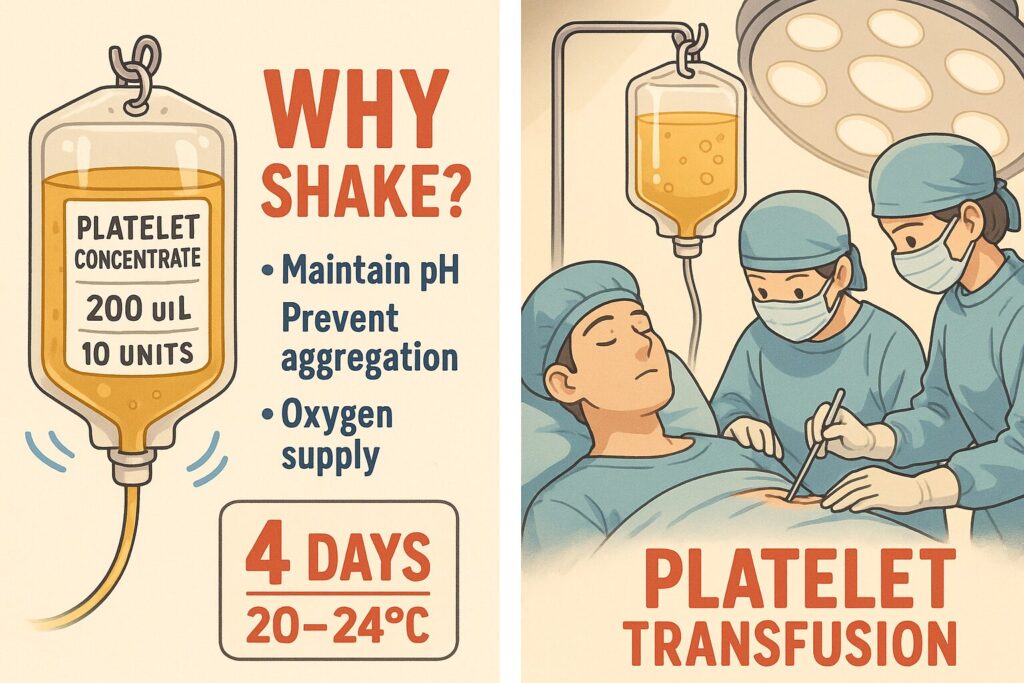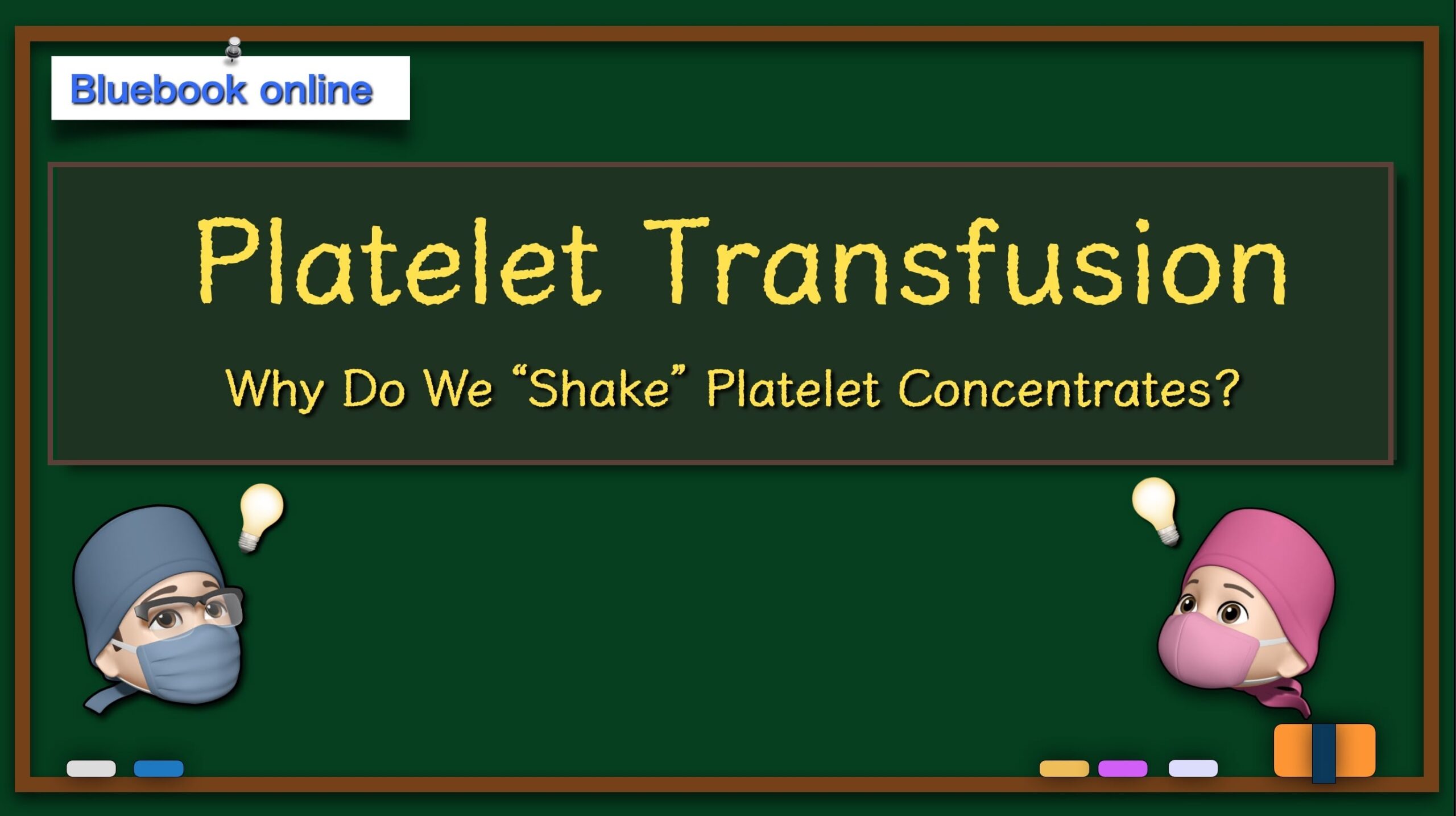👉👉 🇺🇸 All Posts 🇬🇧 / 🇯🇵 記事一覧 🇯🇵 👈👈
♦️ Introduction
Outside of cardiovascular cases where platelet transfusion is often routine, the situation in which we actually transfuse platelets during surgery is usually when things are already tough — massive bleeding, unstable hemodynamics… those moments when you really don’t want to be caught unprepared (´・_・`).

Why Do We Shake Platelet Concentrates?
Platelet concentrates (PC) are prepared as pooled units. One standard bag (10 units in Japan) contains about 200 mL with roughly 200 billion platelets. They must be stored at 20–24°C with continuous gentle agitation. But why the shaking?
- Maintain pH: Platelets are metabolically active and produce lactate, which can acidify the storage medium. Gentle agitation helps maintain gas exchange and prevents pH from dropping.
- Prevent aggregation: If left still, platelets tend to clump together. Shaking reduces this risk.
- Oxygen supply: Platelet metabolism requires oxygen. Agitation allows slightly better oxygen delivery, although the plastic bags are not highly oxygen-permeable, so this contribution is limited.
👉 Unlike red blood cells, which are refrigerated, platelets must never be stored cold — chilling activates them and causes aggregation.
- Shelf life: In Japan, storage is generally 4 days (some facilities extend to 5 days).
- In many Western countries (e.g., the US), storage up to 5–7 days is permitted, but bacterial contamination risk is a concern everywhere.
- Cost: In Japan, 10 units cost about ¥77,000 (≈ USD 500–600).
- In the US, the cost is often reported as USD 500–700 per unit (and multiple units are usually transfused). Either way, platelets are expensive and scarce — making their rational use crucial.
When Do We Use Them?
There is no absolute universal threshold, but in general:
- For most surgeries: transfusion is considered when the platelet count falls below about 50,000/μL or is strongly expected to.
- For minor superficial surgery under local anesthesia: procedures may be performed safely at 20,000/μL or even 10,000/μL, according to reports.
- Massive bleeding: if blood loss reaches 1.5 times the circulating blood volume (≈ 5–6 L in an average adult), platelet transfusion becomes necessary.
⚠️ Reality check: Most hospitals (especially without a transfusion department) do not stock platelets on site. If you wait until massive bleeding has already occurred before ordering, it’s often too late. Early anticipation and ordering are critical — though admittedly not always easy in practice.
How Effective Is One 10-Unit Bag?
The expected increment can be estimated using this formula:
Predicted platelet increment (/μL) = [Total transfused platelets ÷ circulating blood volume (L)] × (2/3)
Example:
- 60 kg adult (≈ 4 L blood volume)
- 200 billion transfused platelets → Predicted increment: about 35,000/μL
The factor “2/3” is the distribution factor: some transfused platelets are sequestered in the spleen and do not appear in peripheral counts.
- Pregnancy: circulating volume increases 1.4–1.5 times, so the expected increment is lower.
- Clinical reality: the actual rise varies widely due to consumption, splenic sequestration, and ongoing bleeding.
✅ Key Take-Home Points
- Platelet concentrate (PC): 10 units ≈ 200 mL, ~200 billion platelets
- Storage: 20–24°C with agitation
- pH maintenance, prevent aggregation, support oxygenation
- Shelf life: 4 days in Japan; 5–7 days in many countries
- Cost: ~¥77,000/10 units in Japan; ~USD 500–700 per unit in the US
- When to transfuse:
- <50,000/μL for most surgeries (as a general guide)
- Minor local surgery possible at ~10–20,000/μL
- Massive bleeding >1.5 × blood volume
- Effect: 10 units raise platelet count by ~30–40,000/μL (but with large individual variation)
👉 Bottom line: Platelets are precious, fragile, and short-lived. Proper storage, timely decision-making, and rational use are essential.
🔗 Related articles
- 🩸Autologous Blood Transfusion Explained: What You Need to Know Before Surgery
- 🩸Has the FFP thawed yet?🫠
- 🩸Red Blood Cell Transfusion (RCC) ~Will the bleeding stop? Surgeon says yes… Anesthesiologist says 🤔
- 🩸What Are Blood Types A, B, O, and AB?
- 🩸What do the labels “lr” and “LR” on blood products mean?
- 🩸Type & Screen, Crossmatch, and Antibodies – Can You Explain Them?

コメントを投稿するにはログインしてください。